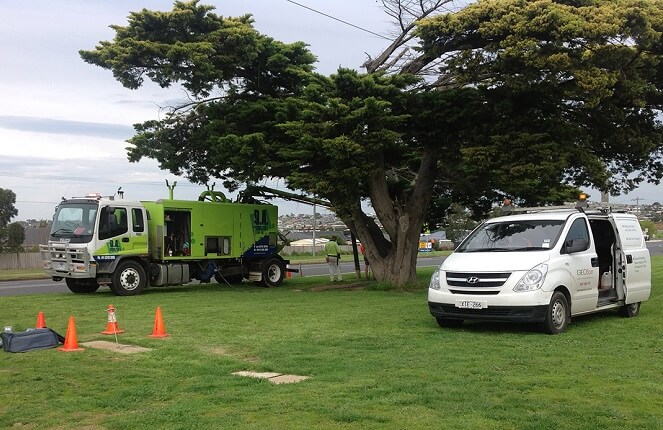For underground utility locating, GPR (Ground Penetrating Radar) works as a corresponding tool to EM. Whereas the EM method is used to locate active utilities beneath the ground, GPR utility location services help locate and identify different elements that are different from their surroundings.
Let's take a look at two of the most common yet challenging scenarios and how we can make the most out of the underground utility locating data available:
1. Multiple Targets
In the presence of multiple buried targets such as rocks, roots, trees, etc., separating buried utilities from them can be quite challenging. Before planning any excavation, one needs to identify target responses from different depths and oriented in different directions.
2. Weak Targets
Varied composition targets result in highly fluctuated GPR reflection responses depending upon the different soil conditions and depth. Also, as the composition of conduit utilities and non-metallic pipes contrasts with the properties of the host material, they often create weak responses. In such instances when the response is weak, targets are usually overlooked.
Strategies That Can Help Get the Most from the Available Data
1. MapView & Interpretation
During underground utility locating, existing records of utility maps offer initial assistance. Further, one needs to create site sketch maps based on observed targets and features. MapView allows us to see the entire surveyed area with all the analysis precisely marked on the screen.
While collecting data, the utility location services provider adds colour-coded interpretations which provides discrimination between the targets and ensures that all the targets are market.
To ensure that the entire area is properly covered, pay special attention to the direction, pattern and spacing of the ground-penetrating radar data path.
2. Depth Slicing
When there are multiple utilities underneath the ground, depth slicing is the best tool to look for linear subsurface. It collects GPR data at varying depths and generates a 2D map image for the same. The latest GPR (ground penetrating radar) systems direct the locator through set-up, data collection, processing and exhibit depth slice. GPR with accurate GPS allows you to produce a depth slice from the line collection.
As depth slicing helps to visualise the targets and highlight utilities, it can widely help with the first challenge.
3. Interpretation Overlaid on Depth Slices
For MapViews of user-selected utilities, depth slicing works as a complimentary. For the weak responses that aren't highlighted in a depth slice, MapView allows the utility location services provider to highlight those responses to the best of his experience and knowledge. The combination of depth slicing and MapViews has proven to be highly beneficial in complex areas.
When the target responses in the GPR cross-section are too weak to appear in a depth slice but are visible to the naked eye, it is advised to map the weak hyperbolas. This can be done by adding user selected point interpretation to the weak responses.
There is a range of varied options available to choose the interpretation colour to place on a hyperbola.
- Choose interpretation colour based on the colour code of utility marking
- Choose the colour code based on the hyperbolic response strength
What's Important is to Choose One Colour Convention and Stick to it Throughout the Project?
Once the point interpretations are added, look in the MapView for the patterns made by interpretations. Some might line up, representing a linear object (mostly a utility) while some might not line up, those are point targets. Adding interpretations and overlaying them on depth slices helps identify and map utilities that do not appear on the depth slices.
Interpretations and depth slicing are the key methods to untangle complex excavation sites and identify missed utilities as a result of their weak responses. Undoubtedly, safety and damage prevention is of paramount importance for safe excavation.
To ensure accurate underground utility locating and mapping, hire professional locators and use all the tools to their best potential.
Author's Bio:
Jon Armstrong possesses immense knowledge related to GPR (Ground Penetrating Radar) and underground utility mapping. For several years, he's been associated with GeoScan Utility &Structural Investigation, renowned underground locators known for providing accurate and timely information related to underground pipe location and much more.














